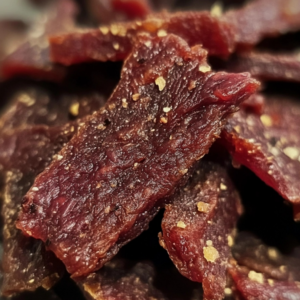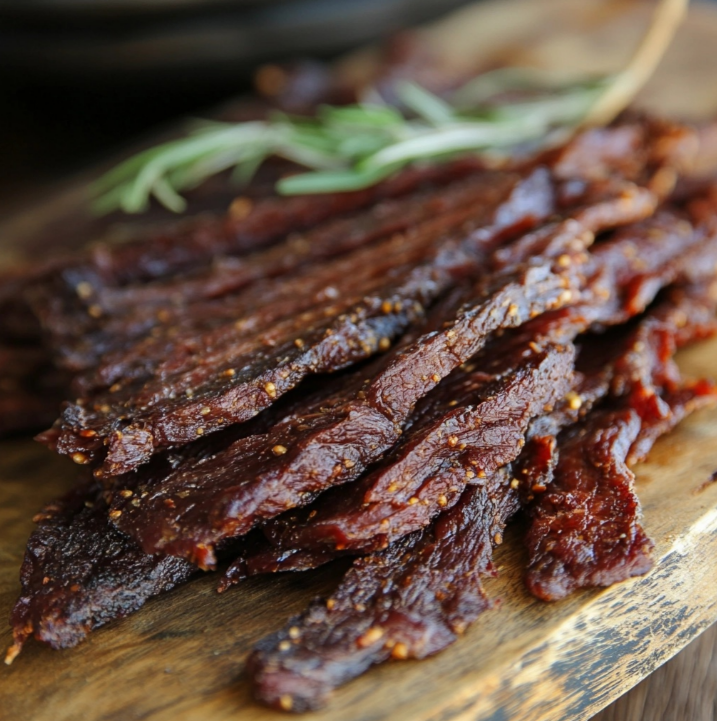Beef jerky is one of the most popular and convenient snacks worldwide. Its high protein content, long shelf life, and delicious flavor make it a favorite for people on the go, hikers, and those looking for a nutritious treat. However, if you’ve ever tried making jerky at home, you know that the cut of meat you use is just as important as the drying process itself. Choosing the right cut can mean the difference between chewy, flavorful jerky and a tough, unpleasant texture.
But with so many beef cuts available, how do you know which one is best for making beef jerky? In this article, we’ll dive deep into the top cuts of meat ideal for jerky, the factors you need to consider when selecting your beef, and answer some frequently asked questions. Whether you’re a seasoned jerky maker or a beginner, this guide will help you produce the best possible jerky every time.
Why Choosing the Right Cut of Meat Matters
The cut of beef you choose has a significant impact on the texture, flavor, and longevity of your jerky. Beef jerky is made by drying or dehydrating thin strips of meat, and because this process involves removing moisture, using a cut with a high-fat content can lead to spoilage. Fat doesn’t dry out well and can turn rancid, giving your jerky an unpleasant taste and reducing its shelf life.
The best cuts for jerky are those that are lean, low in fat, and easy to slice thinly for uniform drying. Tender cuts also produce a better texture, and the way you slice the meat—either with or against the grain—can impact whether your jerky is chewy or tender.
For more detailed food safety recommendations, particularly when drying meat at home, you can check out the CDC’s guidelines for food safety. Following these practices ensures that your jerky is not only delicious but safe to eat.
Factors to Consider When Selecting Beef for Jerky
When selecting beef for jerky, here are the primary factors to keep in mind:
- Leanness: Fat can spoil quickly and doesn’t dry well, so lean cuts are essential for producing jerky that lasts and has a pleasant texture.
- Tenderness: Some cuts of beef are naturally more tender than others. For easier-to-chew jerky, you’ll want a tender cut, especially when sliced properly.
- Grain Direction: Cutting the meat against the grain results in tender jerky, while cutting with the grain produces a chewier texture.
With these factors in mind, let’s explore the best cuts of meat for making beef jerky.
The Best Cuts of Meat for Beef Jerky
1. Eye of Round
Eye of Round is one of the most popular choices for making beef jerky. This cut comes from the cow’s rear leg and is known for being very lean, with minimal fat and sinew. The round shape of this cut also makes it easier to slice into even strips, which is essential for the drying process.

- Benefits of Eye of Round:
- Lean with little fat, reducing the risk of spoilage.
- Uniform shape makes it easy to slice evenly.
- Tender texture when sliced against the grain.
Eye of Round is an affordable option and widely available in most grocery stores. For those looking to make jerky regularly, this is an excellent go-to cut.
2. Top Round
Top Round is another fantastic choice for beef jerky. It’s a lean cut that comes from the upper part of the rear leg of the cow, near the Eye of Round. This cut has a slightly more tender texture than Eye of Round, which makes it a favorite for those who prefer a softer jerky.
- Advantages of Top Round:
- Lean and low in fat, similar to Eye of Round.
- A slightly more tender texture, making it ideal for softer jerky.
- Widely available and relatively inexpensive.
Just like with Eye of Round, trimming any visible fat is crucial. Top Round is a great option if you’re looking for a more tender jerky without sacrificing flavor.
3. Bottom Round
The Bottom Round cut comes from the same area as the Top Round but is slightly tougher. Despite this, it’s still a viable option for jerky as long as it’s prepared and sliced correctly. The toughness can be mitigated by slicing the meat thinly and marinating it for a longer period.
- Key Features of Bottom Round:
- Tougher than Top Round but still lean.
- Requires longer marination to tenderize the meat.
- Very affordable and readily available.
Cutting Bottom Round against the grain will help ensure that your jerky isn’t overly tough, and proper marination will make the meat easier to chew.
4. Sirloin Tip
The Sirloin Tip is another excellent option for jerky. It comes from the round primal of the cow and is lean but flavorful. Sirloin Tip is a great choice for those who want a more flavorful jerky without adding extra fat.
- Advantages of Sirloin Tip:
- Lean and full of flavor.
- Slightly more tender than Round cuts.
- Works well with marinades for extra flavor.
While Sirloin Tip is more expensive than the Round cuts, its robust flavor and leanness make it a worthwhile investment for high-quality jerky.
5. Flank Steak
If you’re looking for a cut that’s packed with flavor, Flank Steak is an excellent option. However, it’s also one of the pricier cuts, and its grain structure requires careful slicing. If you slice it incorrectly, Flank Steak can turn out quite tough.
- Key Features of Flank Steak:
- Rich, deep flavor.
- Requires careful slicing against the grain for tenderness.
- Best for those prioritizing flavor over cost.
Flank Steak is ideal for more advanced jerky makers who are comfortable with the extra preparation steps required to produce high-quality jerky.
Cuts of Meat to Avoid for Beef Jerky
Not all cuts of beef are suitable for jerky. Some cuts are too fatty, and others have a texture that doesn’t lend itself well to the jerky-making process.
1. Ribeye
Ribeye is known for its marbling, which makes it a fantastic cut for steaks but a terrible option for jerky. The high fat content will not dry out properly and can cause the jerky to spoil more quickly.
2. Brisket
Brisket is another cut that, while delicious when smoked or slow-cooked, is far too fatty for jerky. The drying process won’t remove all the fat, leading to an unpleasant texture.
3. Short Ribs
Short Ribs have a lot of connective tissue and fat, making them impractical for jerky. They are also difficult to slice evenly, which can affect the drying process.
Preparing the Meat for Jerky
Once you’ve selected your cut of beef, it’s time to prepare the meat for drying. Proper preparation is essential for producing high-quality jerky.
1. Trimming the Fat
Even with lean cuts of beef, it’s important to trim any visible fat. Fat does not dry well and can become rancid, affecting the taste and shelf life of your jerky. Use a sharp knife to carefully remove any fat before slicing the meat.
2. Slicing the Meat
Slicing the meat correctly is crucial for producing jerky with the right texture. For tender jerky, slice the meat against the grain. This shortens the muscle fibers, making the jerky easier to chew. For a chewier jerky, slice with the grain.
Slices should be around ¼ inch thick. Thinner slices will dry out too quickly and become brittle, while thicker slices may not dry evenly.
3. Marinating the Meat
Marinating your meat adds flavor and helps tenderize it before drying. A good marinade should include a balance of salty, sweet, and savory ingredients. Popular ingredients for beef jerky marinades include:
- Soy sauce
- Worcestershire sauce
- Garlic powder
- Onion powder
- Brown sugar
- Black pepper
For the best results, marinate your meat for 12-24 hours in the refrigerator before drying it.
Table: Nutritional Value of Beef Jerky Cuts
| Cut of Meat | Protein (per 3 oz) | Fat (per 3 oz) | Calories (per 3 oz) |
|---|---|---|---|
| Eye of Round | 23g | 4g | 140 |
| Top Round | 24g | 3g | 130 |
| Sirloin Tip | 22g | 5g | 150 |
| Flank Steak | 21g | 6g | 160 |
For more detailed nutritional information on different beef cuts, check out Beef, It’s What’s For Dinner’s nutrition guide.
Frequently Asked Questions (FAQs) About Beef Jerky
What is the best thickness for beef jerky slices?
The ideal thickness for beef jerky is around ¼ inch. Thicker slices may not dry evenly, while thinner slices can become too brittle during the drying process.
How long should I marinate beef for jerky?
Marinate your beef for at least 12-24 hours for optimal flavor. The longer the marination, the more flavor the meat will absorb.
Can I use fatty cuts of meat for jerky?
It’s not recommended to use fatty cuts of meat for jerky, as fat does not dry well and can spoil. Stick to lean cuts like Eye of Round or Top Round for the best results.
What is the ideal temperature for dehydrating beef jerky?
The ideal temperature for dehydrating beef jerky is around 160°F (70°C). This ensures that the meat is fully dried while maintaining its flavor and safety.
Internal Links to Explore
For more delicious jerky-making tips, you can explore this detailed beef jerky recipe. You might also be interested in learning about the secret to good jerky, which covers more advanced techniques for improving your homemade jerky.
If you’re a fan of hearty meals, try these Philly cheesesteak sliders for a delicious treat, or discover the versatility of tuna with this tuna casserole with potato chips.
Conclusion
In conclusion, the best cut of meat for making beef jerky is a lean, tender, and flavorful one. Cuts like Eye of Round, Top Round, Bottom Round, and Sirloin Tip provide the perfect balance of leanness and flavor, ensuring that your jerky dries evenly and maintains a great taste. Be sure to avoid fatty cuts like Ribeye or Brisket, as they can spoil easily and won’t dry well.
When you take the time to select the right cut of beef, trim the fat, slice the meat properly, and marinate it for long enough, you’ll end up with delicious, homemade jerky that rivals even the best store-bought varieties. Whether you enjoy your jerky as a snack on the go or as a protein-packed addition to your diet, mastering the art of selecting the right beef cut is the first step toward jerky perfection.
